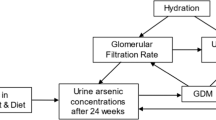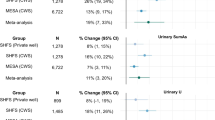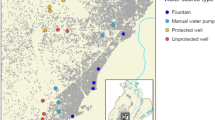Abstract
Following reports of high cytotoxicity and mutagenicity of monomethyl arsonous acid (MMA(III)) and early reports of urinary MMA(III) in arsenic-exposed individuals, MMA(III) has often been included in population studies. Use of urinary MMA(III) as an indicator of exposure and/or health risk is challenged by inconsistent results from field studies and stability studies, which indicate potential artifacts. We measured urinary arsenic species in children chronically exposed to arsenic in drinking water, using collection, storage, and analysis methods shown to conserve MMA(III). MMA(III) was easily oxidized in sample storage and processing, but recoveries of 80% or better in spiked urine samples were achieved. Attempts to preserve the distribution of MMA between trivalent and pentavalent forms using complexing agents were unsuccessful and MMA(III) spiked into treated urine samples actually showed lower stability than in untreated samples. In 643 urine samples from a highly exposed population from the Matlab district in Bangladesh stored for 3–6 months at ≤–70 °C, MMA(III) was detected in 41 samples, with an estimated median value of 0.3 μg/l, and levels of MMA(III) above 1 μg/l in only two samples. The low urinary concentrations in highly exposed individuals and known difficulties in preserving sample oxidation state indicate that urinary MMA(III) is not suitable for use as an epidemiological biomarker.
This is a preview of subscription content, access via your institution
Access options
Subscribe to this journal
Receive 6 print issues and online access
$259.00 per year
only $43.17 per issue
Buy this article
- Purchase on Springer Link
- Instant access to full article PDF
Prices may be subject to local taxes which are calculated during checkout


Similar content being viewed by others
References
WHO. Guidelines for Drinking Water Quality: Recommendations 2nd edn vol. 1. World Health Organization: Geneva, Switzerland. 1993.
International Agency for Research on Cancer. Some Drinking-Water Disinfectants and Contaminants, Including Arsenic. IARC Monographs on the Evaluation of Carcinogenic Risks to Humans vol. 84. World Health Organization: Lyon, France. 2004 p 512.
Smith AH, Steinmaus CM . Health effects of arsenic and chromium in drinking water: recent human findings. Annu Rev Public Health 2009; 30: 107–122.
Agency for Toxic Substances and Disease Registry. Toxicological Profile for Arsenic. ATSDR: Atlanta, GA, USA. 2000.
National Research Council. Arsenic in Drinking Water. National Academy Press: Washington, DC, USA. 2001.
Vahter M . Mechanisms of arsenic biotransformation. Toxicology 2002; 181/182: 211–217.
Thomas DJ, Water SB, Styblo M . Elucidating the pathway for arsenic methylation. Toxicol Appl Pharmacol 2004; 172: 225–232.
Styblo M, Del Razo LM, Vega L, Germolec DR, LeCluyse EL, Hamilton GA et al. Comparative toxicity of trivalent and pentavalent inorganic and methylated arsenicals in rat and human cells. Arch Toxicol 2000; 74: 289–299.
Mass MJ, Tennant A, Roop BC, Cullen WR, Styblo M, Thomas DJ et al. Methylated trivalent arsenic species are genotoxic. Chem Res Toxcicol 2001; 14: 355–361.
Lindberg A-L, Kumar R, Goessler W, Thirumaran R, Gurzau E, Koppova K et al. Metabolism of low-dose inorganic arsenic in a central European population: influence of sex and genertic polymorphisms. Environ Health Perspect 2007; 115: 1081–1086.
Currier JM, Svoboda M, Matousek T, Dedina J, Styblo M . Direct analysis and stability of methylated trivalent arsenic metabolites in cells and tissues. Metallomics 2011; 3: 1347–1354.
Tseng C-H . A review on environmental factors regulating arsenic methylation in humans. Toxicol Appl Pharmacol 2009; 235: 338–350.
Del Razo LM, Styblo M, Cullen WR, Thomas DJ . Determination of trivalent methylated arsenicals in biological matrices. Toxicol Appl Pharmacol 2001; 174: 282–293.
Mandal BK, Ogra Y, Suzuki KT . Identification of dimethylarsinous and monomethyl arsonous acid in human urine of the arsenic-affected areas in West Bengal, India. Chem Res Toxicol 2001; 14: 371–378.
Mandal BK, Ogra Y, Anzai K, Suzuki KT . Speciation of arsenic in biological samples. Toxicol Appl Pharmacol 2004; 198: 307–318.
Valenzuela OL, Borja-Aburto VH, Garcia-Vargas GG, Cruz-Gonzalez MB, Garcia-Montalvo EA, Calderon-Aranda ES et al. Urinary trivalent methylated arsenic species in a population chronically exposed to inorganic arsenic. Environ Health Perspect 2005; 113: 250–254.
Engstrom KS, Broberg K, Concha G, Nermell B, Warholm M, Vahter M . Genetic polymorphisms influencing arsenic metabolism: evidence from Argentina. Environ Health Perspect 2007; 115: 599–605.
Rabieh S, Hirner AV, Matschullat J . Determination of arsenic species in human urine using high performance liquid chromatography (HPLC) coupled with inductively coupled plasma mass spectrometry (ICP-MS). J Anal At Spectrom 2008; 23: 544–549.
Gong Z, Lu X, Cullen WR, Le XC . Unstable trivalent arsenic metabolites, monomethylarsonous acid and dimethylarsinous acid. J Anal At Spectrom 2001; 16: 1409–1413.
Francesconi KA, Kuehnelt D . Determination of arsenic species: a critical review of methods and applications, 2000–2003. Analyst 2004; 129: 373–395.
Aposhian HV, Gurzau ES, Le XC, Gurzau A, Healy SM, Lu X et al. Occurrence of monomethylarsonous acid in urine of humans exposed to inorganic arsenic. Chem Res Toxicol 2000; 13: 693–697.
Le XC, Lu X, Cullen WR, Aposhian HV, Zheng B . Speciation of key arsenic metabolic intermediates in human urine. Anal Chem 2000; 72: 5172–5177.
Le XC, Ma M, Lu X, Cullen WR, Aposhian HV, Zheng B . Determination of monomethylarsonous acid, a key methylation intermediate, in human urine. Environ Health Perspect 2000a; 108: 1015–1018.
Feldmann J, Lai VW-M, Cullen WR, Ma M, Lu X, Le XC . Sample preparation and storage can change arsenic speciation in human urine. Clin Chem 1999; 45: 1988–1997.
Currier JM, Svoboda M, de Moraes DP, Matousek T, Dedina J, Styblo M . Direct analysis of methylated arsenicals in mouse liver by hydride generation-cryotrapping-atomic absorption spectrometry. Chem Res Toxicol 2011; 24: 478–480.
Steinmaus C, Yuan Y, Kalman D, Rey OA, Skibola CF, Dauphine D et al. Individual differences in arsenic metabolism and lung cancer in a case–control study in Cordoba, Argentina. Toxicol Appl Pharmacol 2010; 247: 138–145.
Chung J, Kalman DA, Moore LE, Kosnett MJ, Arroyo AP, Beeris M et al. Family correlations of arsenic methylation patterns in children and parents exposed to high concentrations of arsenic in drinking water. Environ Health Perspect 2002; 110: 729–733.
Styblo M, Serves SV, Cullen WR, Thomas DJ . Comparative inhibition of yeast glutathione reductase by arsenicals and arsenothiols. Chem Res Toxicol 1997; 10: 27–33.
Jiang G, Lu X, Gong Z, Cullen WR, Le XC . Trivalent arsenic species: analysis, stability, and interaction with a protein. In: Chappell WR, Abernathy CO, Calderon RL and Thomas DL (eds). Arsenic Exposure and Health Effects V. Elsevier BV: Amsterdam, Netherlands. 2003 pp 51–68.
Dubois D, Dubois EF . A formula to estimate the approximate surface area if height and weight be known. Arch Intern Med 1916; 17: 863–871.
Chen Y-C, Amarasiriwardena CJ, Hsueh Y-M, Christiani DC . Stability of arsenic species and insoluble arsenic in human urine. Cancer Epidemiol Biomarkers Prev 2002; 11: 1427–1433.
Yehiayan L, Pattabiraman M, Kavallieratos K, Wang X, Boise L, Cai Y . Speciation, formation, stability, and analytical challenges of human arsenic metabolites. J Anal At Spectrom 2009; 24: 1397–1405.
Slejkovec Z, Falnoga I, Goesselr W, van Elteren JT, Raml R, Podgornik H et al. Analytical artifacts in the speciation of arsenic in clinical samples. Analyt Chim Acta 2008; 607: 83–91.
Wang Z, Zhou J, Lu X, Gong Z, Le XC . Arsenic speciation in urine from acute promyelocytic leukemia patients undergoing arsenic trioxide treatment. Chem Res Toxicol 2004; 17: 95–103.
Rivera-Núñez Z, Meliker JR, Aaron M, Linder AM, Nriagu JO . Reliability of spot urine samples in assessing arsenic exposure. Int J Hyg Environ Health 2010; 213: 259–264.
Rivera-Núñez Z, Linder AM, Chen B, Nriagu JO . Low-level determination of six arsenic species in urine by high performance liquid chromatography-inductively coupled plasma-mass spectrometry (HPLC-ICP-MS). Anal Methods 2011; 3: 1122–1129.
Rivera-Núñez Z, Meliker JR, Meeker JD, Slotnick MJ, Nriagu JO . Urinary arsenic species, toenail arsenic, and arsenic intake estimates in a Michigan population with low levels of arsenic in drinking water. J Expos Sci Environ Epidemiol 2011; 22: 182–190.
Del Razo LM, Garcia-Vargas GG, Valenzuela OL, Castellanos EH, Sanchez-Pena LC, Currier JM et al. Exposure to arsenic in drinking water is associated with increased prevalence of diabetes: a cross-sectional study in the Zimapán and Lagunera regions in Mexico. Environ Health 2011; 10: 73.
Acknowledgements
This work was supported by the National Institutes of Health Grant Nos. R01-HL081520 and P42-ES04705. We acknowledge with gratitude the commitment of NIH to our research efforts.
Author information
Authors and Affiliations
Corresponding author
Ethics declarations
Competing interests
The authors declare no conflict of interest.
Rights and permissions
About this article
Cite this article
Kalman, D., Dills, R., Steinmaus, C. et al. Occurrence of trivalent monomethyl arsenic and other urinary arsenic species in a highly exposed juvenile population in Bangladesh. J Expo Sci Environ Epidemiol 24, 113–120 (2014). https://doi.org/10.1038/jes.2013.14
Received:
Accepted:
Published:
Issue Date:
DOI: https://doi.org/10.1038/jes.2013.14



